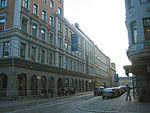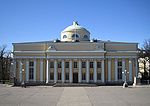Helsinki University Library
2010 establishments in FinlandLibraries in FinlandUniversity of Helsinki

The Helsinki University Library (Finnish: Helsingin yliopiston kirjasto) is the largest multidisciplinary university library in Finland. It was established on 1 January 2010. The Helsinki University Library is an independent institute of the University of Helsinki and open to all information seekers. The Helsinki University Library includes the Main Library in the Kaisa House, Kumpula, Meilahti and Viikki Campus Libraries, as well as internal library services. The library offers information and library services in the fields of science of all four campuses of the University of Helsinki.
Excerpt from the Wikipedia article Helsinki University Library (License: CC BY-SA 3.0, Authors, Images).Helsinki University Library
Kaisaniemenkatu, Helsinki Kaisaniemi (Southern major district)
Geographical coordinates (GPS) Address Nearby Places Show on map
Geographical coordinates (GPS)
| Latitude | Longitude |
|---|---|
| N 60.1714 ° | E 24.9483 ° |
Address
Kaisa-talo
Kaisaniemenkatu 5
00014 Helsinki, Kaisaniemi (Southern major district)
Finland
Open on Google Maps







